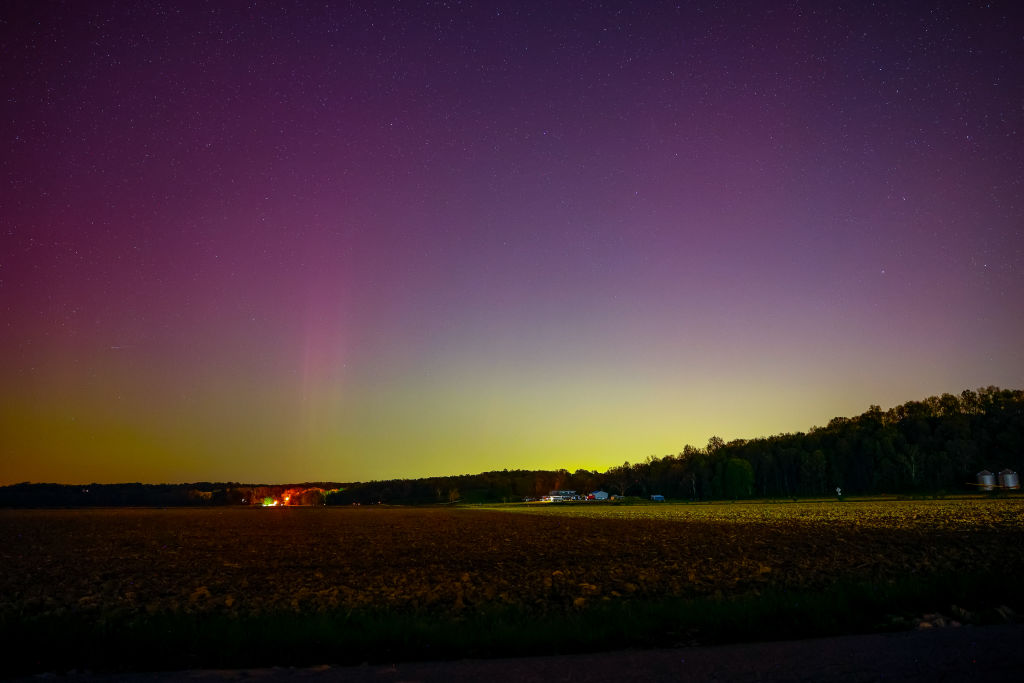
Seventeen states in the U.S. could get a glimpse at the Northern Lights this week, thanks to a geomagnetic storm impacting the atmosphere mid-week.
The Northern Lights, or aurora borealis, will be visible across areas like Seattle, Des Moines [Iowa], Chicago, Cleveland, Boston, and Halifax [Nova Scotia] on Wednesday. That night the KP-index, which measures global auroral activity ranges from 0 to 9, will be at Kp-5. Anything above a Kp-5 rating means a geomagnetic storm will occur.
On Thursday, the aurora will intensify as the KP-index increases, making the colorful lights more visible, according to The Geophysical Institute at the University of Alaska at Fairbank.
Here’s what to know about the Northern Lights.
What are the Northern Lights?
The Northern Lights are an astronomical phenomenon that are usually seen along the magnetic poles of the northern and southern hemispheres. Due to the solar storm, the Northern Lights will be seen farther south than usual this week.
The different colored lights are “caused by collisions between electrically charged particles streaming out from the sun in the solar wind that enter Earth’s atmosphere and collide with molecules and atoms of gas, primarily oxygen and nitrogen,” according to the University of Alaska at Fairbanks.
Those particles release light, causing a beautiful array of colors across the sky. The aurora is usually green-colored, but that can vary depending on where the collisions occur and the composition and density of the atmosphere.
More from TIME
How and where can you possibly see them?
The Geophysical Institute at the University of Alaska at Fairbanks says that the aurora borealis will be visible across parts of Washington, Idaho, Vermont, Wyoming, New Hampshire, Montana, North Dakota, South Dakota, Minnesota, Nebraska, Massachusetts, Maryland, Ohio, Wisconsin, Michigan, New York and Maine on July 12 and 13. Lights will also be visible in parts of Canada, including Vancouver.
The aurora will be visible “low on the horizon” across cities like Boston, Chicago, Cleveland and Seattle. In towns like Milwaukee, Minneapolis and Helena, Montana, the lights will be visible overhead.
The best time to see the aurora is between 10 p.m. and 2 a.m. local time, per the National Oceanic and Atmospheric Administration (NOAA), though people should try to get away from city lights for a better view. Even the light from the full moon could diminish the aurora, the NOAA adds. Experts also advise people to find a spot where they can see the north with an “unobstructed view,” so it may help to get to higher ground.
People can check forecasts for the aurora on the NOAA’s page.
The upcoming storm marks the fourth solar storm since 2019, as the Northern Lights were last seen across 30 states in April.
More Must-Reads from TIME
- Cybersecurity Experts Are Sounding the Alarm on DOGE
- Meet the 2025 Women of the Year
- The Harsh Truth About Disability Inclusion
- Why Do More Young Adults Have Cancer?
- Colman Domingo Leads With Radical Love
- How to Get Better at Doing Things Alone
- Michelle Zauner Stares Down the Darkness
Contact us at letters@time.com